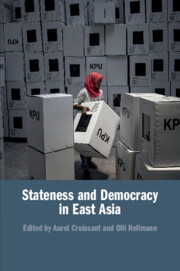Book contents
- Stateness and Democracy in East Asia
- Stateness and Democracy in East Asia
- Copyright page
- Contents
- Figures
- Tables
- Contributors
- Acknowledgements
- 1 Introduction: Rethinking Stateness and Democracy in East Asia
- 2 State-Building and Democratization
- 3 South Korea’s Democracy and the Legacies of the Developmental State
- 4 After Hegemony: State Capacity, the Quality of Democracy and the Legacies of the Party-State in Democratic Taiwan
- 5 Democratization Interrupted: The Parallel State and the Demise of Democracy in Thailand
- 6 Weak State and the Limits of Democratization in Cambodia, 1993–2017
- 7 The Institutional Roots of Defective Democracy in the Philippines
- 8 Stateness and State Capacity in Post-Authoritarian Indonesia: Securing Democracy’s Survival, Entrenching Its Low Quality
- 9 As Good as It Gets? Stateness and Democracy in East Timor
- 10 Stateness and Democracy: Evidence from East Asia and Cross-Regional Comparisons
- Index
- References
9 - As Good as It Gets? Stateness and Democracy in East Timor
Published online by Cambridge University Press: 13 May 2020
- Stateness and Democracy in East Asia
- Stateness and Democracy in East Asia
- Copyright page
- Contents
- Figures
- Tables
- Contributors
- Acknowledgements
- 1 Introduction: Rethinking Stateness and Democracy in East Asia
- 2 State-Building and Democratization
- 3 South Korea’s Democracy and the Legacies of the Developmental State
- 4 After Hegemony: State Capacity, the Quality of Democracy and the Legacies of the Party-State in Democratic Taiwan
- 5 Democratization Interrupted: The Parallel State and the Demise of Democracy in Thailand
- 6 Weak State and the Limits of Democratization in Cambodia, 1993–2017
- 7 The Institutional Roots of Defective Democracy in the Philippines
- 8 Stateness and State Capacity in Post-Authoritarian Indonesia: Securing Democracy’s Survival, Entrenching Its Low Quality
- 9 As Good as It Gets? Stateness and Democracy in East Timor
- 10 Stateness and Democracy: Evidence from East Asia and Cross-Regional Comparisons
- Index
- References
Summary
The chapter analyses the simultaneous state-building and democratization process in East Asia’s newest sovereign nation-state. Since 2002, East Timor has strived to create a democratic and effective state out of the ashes of colonial rule, armed conflict and foreign occupation. With the assistance of the United Nations (UN), East Timor has thus undergone a process of simultaneous state and democracy building. Despite tremendous challenges, democracy has been surprisingly resilient against a number of severe crises. East Timor thereby represents a highly unusual mix of a fragile stateness but, given the circumstances, a relatively resilient (though, low-quality) democracy. This chapter investigates the reasons for and the implications of this surprising combination. In so doing, the chapter demonstrates that democratization and democracy have contributed to further consolidation of nation-building and statehood in East Timor. At the same time, however, limited stateness is one of the main reasons why democracy remains of low quality.
Keywords
- Type
- Chapter
- Information
- Stateness and Democracy in East Asia , pp. 204 - 232Publisher: Cambridge University PressPrint publication year: 2020
References
- 6
- Cited by



